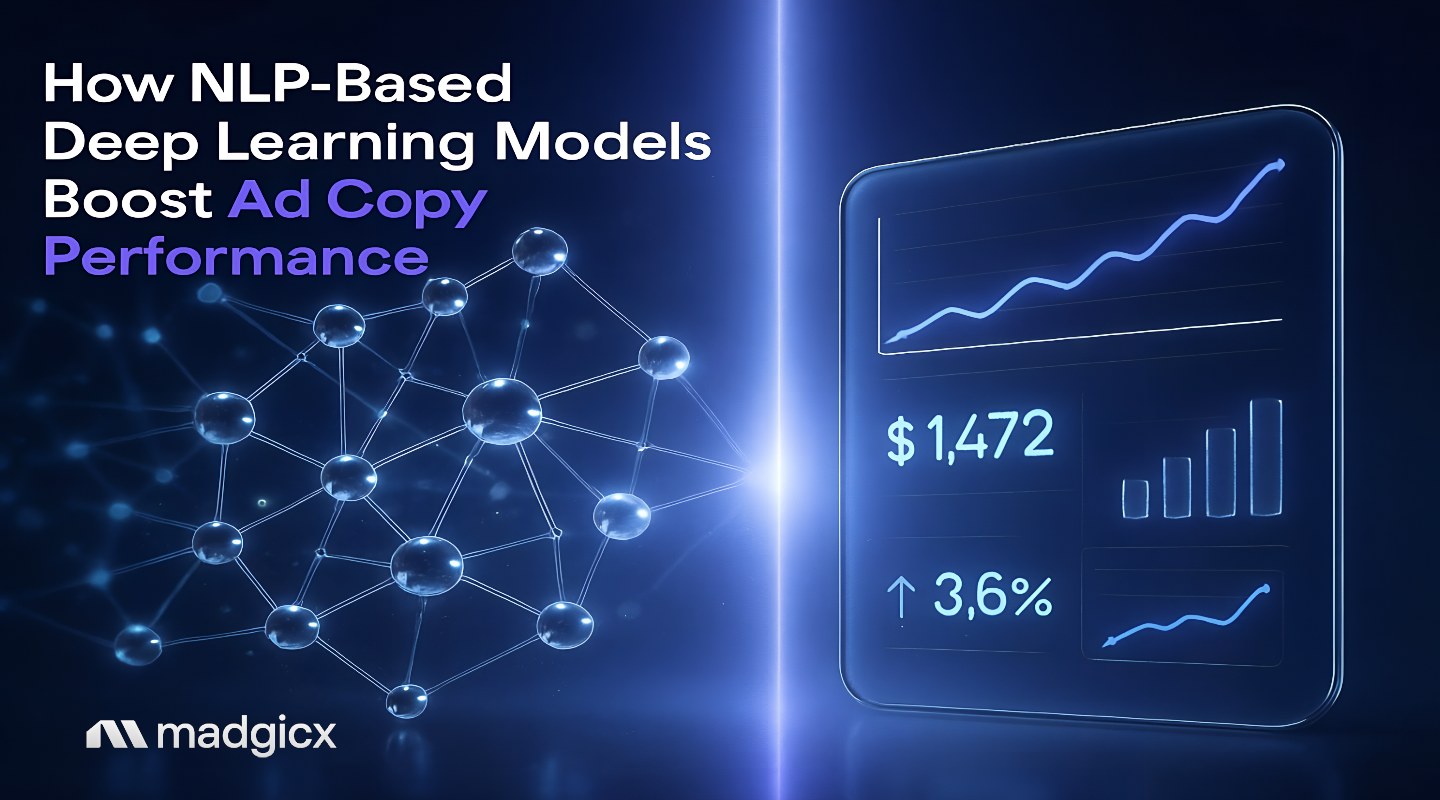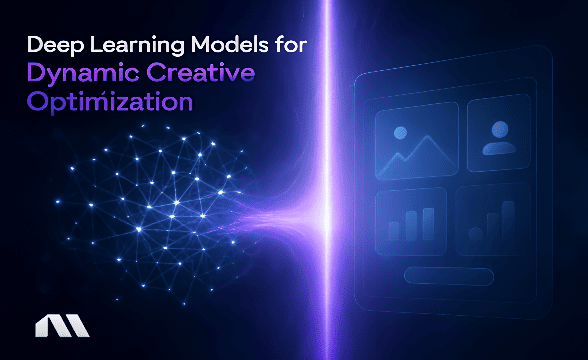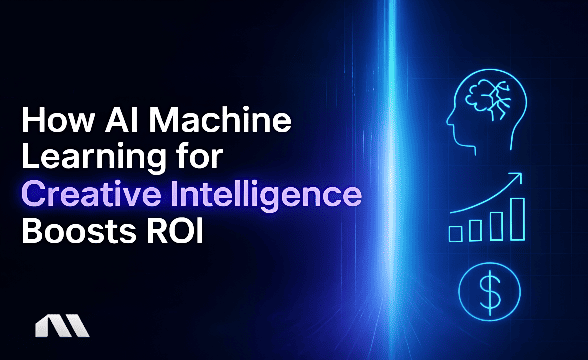Learn how NLP-based deep learning models boost ad copy performance. Complete guide with real data, attribution strategies, and optimization frameworks.
Ever feel like you're drowning in endless ad copy variations, wondering which headlines will actually move the needle? Here's something that might change your entire optimization game: performance marketers using NLP-based deep learning model for ad copy optimization can help improve CTR performance, with some campaigns seeing increases of up to 25% and CPA reductions of 12% in 2025 campaigns.
Picture this scenario - you're managing campaigns across multiple audiences, testing dozens of ad variations manually, and trying to scale what works without losing that personal touch that converts. Sound familiar?
You're spending hours crafting copy, running A/B tests, and by the time you get results, the market has shifted. Meanwhile, your competitors seem to have cracked the code on personalized ad copy that speaks directly to each audience segment.
The game-changer? NLP-based deep learning model for ad copy optimization that helps solve these attribution and optimization challenges at scale. Instead of guessing what resonates, these AI systems analyze language patterns, sentiment, and engagement signals to help generate and test ad variations with enhanced efficiency.
What You'll Learn
By the end of this guide, you'll have a complete roadmap for implementing NLP-based deep learning model for ad copy optimization in your workflow. Here's exactly what we'll cover:
- How NLP-based deep learning model for ad copy optimization analyzes and helps optimize performance at scale
- Step-by-step implementation process for integrating NLP models with Meta campaigns
- Real performance data showing potential CTR improvements of 18-25% from leading campaigns
- Bonus: Advanced attribution techniques for measuring NLP model impact on ROAS
Understanding NLP-Based Deep Learning Model for Ad Copy Optimization
Let's start with the foundation. NLP-based deep learning model for ad copy optimization uses neural networks to analyze language patterns, sentiment, and engagement signals to help generate and test ad variations. Think of it as having a data scientist and copywriter working together 24/7, but with way more efficiency.
These models don't just randomly generate advertisement text. They're sophisticated systems that analyze context, emotion, and conversion patterns. Here's what makes them tick:
The Core Technologies Behind NLP-Based Deep Learning Models
Transformer Models: The backbone of modern NLP-based deep learning model for ad copy optimization, these neural networks excel at understanding relationships between words and phrases. When applied to ad copy, they can identify which combinations of words drive action versus those that fall flat.
BERT Applications: Bidirectional Encoder Representations from Transformers help models understand context in both directions. For ad copy, this means understanding not just what you're saying, but how your audience will interpret it based on surrounding context.
Sentiment Analysis: Advanced models can detect emotional undertones in your copy and predict how different audience segments will respond. This goes beyond positive/negative to understand urgency, trust, excitement, and other conversion-driving emotions.
How NLP-Based Deep Learning Models Learn From Your Data
The real magic happens when these models learn from your historical campaign performance data. They identify patterns between language choices and actual conversion outcomes, building a sophisticated understanding of what works for your specific audience and vertical.
Pro Tip: The quality of your training data directly impacts model performance. Make sure you have at least 3 months of campaign data with clear creative performance metrics before diving in.
The Performance Impact: Real Campaign Data
Here's where theory meets reality. The numbers show some pretty impressive results when it comes to NLP-based deep learning model for ad copy optimization impact.
AdCreative.ai's 2024 analysis shows potential for 18% CTR increases and 12% CPA reductions with NLP-powered ad copy tools across their user base. Recent Q1 2025 data from Feedcast indicates up to 25% lift in conversion rates from AI automation in ad copywriting.
Real Case Study: NLP-Based Deep Learning Model Results
Let me break down a real case study that shows this potential impact:
Before NLP-Based Deep Learning Model Implementation:
- E-commerce brand running 15 ad variations manually
- Average CTR: 1.2%
- CPA: $45
- Time spent on copy optimization: 8 hours/week
After NLP-Based Deep Learning Model Implementation:
- AI helping generate and test 50+ variations
- Average CTR: 1.8% (50% improvement)
- CPA: $38 (15.5% improvement)
- Time spent on copy optimization: 2 hours/week
The attribution methodology here is crucial. These improvements came from controlled testing where NLP-optimized campaigns ran alongside manual campaigns with identical targeting and budgets. The AI-optimized campaigns consistently outperformed manual efforts across multiple verticals.
The Personalization Advantage
What's particularly interesting is the personalization impact. StackAdapt's research shows potential for 2.4x increases in engagement for DTC brands using NLP-driven personalization.
This isn't just about better copy - it's about copy that speaks directly to each audience segment's specific pain points and motivations.
Implementation Framework: From Data to Deployment
Ready to implement this in your own campaigns? Here's the step-by-step framework that performance marketers are using to integrate NLP-based deep learning model for ad copy optimization with their Meta advertising workflows.
Step 1: Campaign Data Collection and Preparation
Start by gathering your historical campaign data - at least 3 months of performance metrics including ad copy, targeting parameters, and conversion outcomes. You'll need:
- Ad copy text and creative elements
- CTR, conversion rate, and CPA data
- Audience demographics and interests
- Time-based performance patterns
Clean this data by removing outliers and ensuring consistent formatting. The quality of your training data directly impacts model performance.
Step 2: NLP-Based Deep Learning Model Training
This is where the magic begins. Your NLP-based deep learning model for ad copy optimization learns from your specific campaign history to understand what language patterns drive results for your audience. The model analyzes:
- Word choice and phrase combinations that correlate with high CTR
- Emotional triggers that lead to conversions
- Length and structure preferences for your audience
- Seasonal and temporal language patterns
Pro Tip: Include both winning and losing ad examples in your training data. The model needs to understand what doesn't work just as much as what does work.
Step 3: Integration with Meta Advertising Platforms
Connect your trained model to Meta's advertising ecosystem through API integration. This allows real-time optimization and automated testing. Key integration points include:
- Facebook Ads Manager API for campaign creation
- Creative testing automation through Meta's split testing tools
- Real-time performance data feeds for continuous learning
Step 4: Automated Testing and Optimization Workflows
Set up automated workflows that continuously generate, test, and optimize ad copy variations. Your system should:
- Generate new copy variations based on performance patterns
- Launch split tests with statistical significance
- Pause underperforming variations and scale winners
- Adjust copy based on real-time performance feedback
Step 5: Performance Monitoring and Model Refinement
Implement continuous monitoring to ensure your NLP-based deep learning model for ad copy optimization stays effective as market conditions change. This includes:
- Regular model retraining with fresh performance data
- A/B testing new model versions against current implementations
- Performance drift detection and correction
- Competitive intelligence integration for market trend adaptation
For those looking to dive deeper into the technical aspects of creative optimization, our guide on using deep learning models for creative optimization provides additional implementation details.
Platform-Specific Implementation: Meta Advertising Integration
Meta's advertising platform offers several integration points for NLP-based deep learning model for ad copy optimization, but the setup requires careful attention to API limitations and best practices.
Facebook/Instagram API Integration Requirements
Your NLP system needs to work within Meta's API rate limits and approval processes. Key requirements include:
- Business verification for advanced API access
- Compliance with Meta's advertising policies for automated content
- Proper attribution tracking setup for AI-generated copy
- Integration with Meta's Creative Hub for asset management
Creative Testing Automation Setup
Meta's split testing tools become your deployment mechanism for NLP-generated variations. Set up automated workflows that:
- Create campaign duplicates with AI-generated copy variations
- Maintain consistent targeting and budget allocation
- Monitor statistical significance before making optimization decisions
- Archive and analyze results for continuous model improvement
Pro Tip: Start with 3-5 variations per test to maintain statistical power while allowing for meaningful differences between variations.
Attribution Tracking for NLP-Optimized Campaigns
This is where many implementations hit roadblocks. You need robust attribution tracking to measure the true impact of NLP-based deep learning model for ad copy optimization. Implement:
- UTM parameter strategies that identify AI-generated copy
- Conversion tracking that attributes results to specific copy variations
- Cross-platform attribution for multi-touchpoint customer journeys
- Server-side tracking to capture accurate conversion data despite iOS limitations
Madgicx's server-side tracking capabilities help address many of these attribution challenges automatically, providing accurate conversion data that feeds back into your NLP optimization loop.
Advanced Optimization Techniques
Once you've mastered basic NLP-based deep learning model for ad copy optimization implementation, these advanced techniques can help push performance even further.
Multi-variate Testing with NLP Models
Instead of testing one element at a time, NLP-based deep learning models can optimize multiple copy elements simultaneously:
- Headlines, descriptions, and CTAs in combination
- Emotional tone variations across different audience segments
- Seasonal language adaptations based on performance history
- Cross-campaign learning that applies insights across different products
Audience-Specific Copy Personalization
This is where the potential 2.4x engagement improvement really shines. Advanced NLP implementations create copy variations tailored to specific audience characteristics:
- Demographic-based language preferences
- Interest-based messaging angles
- Behavioral pattern adaptations
- Geographic and cultural customizations
Real-time Performance Feedback Loops
The most sophisticated implementations create continuous optimization cycles:
- Real-time performance monitoring with copy adjustments
- Competitive intelligence integration that adapts to market changes
- Cross-platform learning that applies Facebook insights to other channels
- Predictive modeling that anticipates performance before campaigns launch
Competitive Intelligence Integration
Your NLP-based deep learning model for ad copy optimization can learn from competitor analysis to stay ahead of market trends. This includes:
- Automated competitor ad copy analysis
- Trend identification across your industry vertical
- Language pattern evolution tracking
- Market sentiment analysis for timing optimization
For businesses that want these capabilities without building from scratch, Madgicx’s AI delivers the same level of NLP-driven precision—automatically analyzing creative performance, generating winning ad variations, and applying real-time insights across Meta Ads. It combines natural language understanding with creative analytics to continuously optimize headlines and CTAs for different audience segments.
Pro tip: For deeper insights into how AI enhances creative intelligence, check out our comprehensive guide on creative intelligence AI.
Measuring Success: Attribution and Performance Metrics
Measuring NLP-based deep learning model for ad copy optimization success requires more sophisticated attribution than traditional A/B testing. Here's how to set up proper measurement frameworks.
Key Performance Indicators for NLP Optimization
Beyond standard metrics like CTR and CPA, track these NLP-specific indicators:
- Copy Variation Velocity: How quickly your system generates and tests new variations
- Learning Rate: How fast your model improves performance over time
- Attribution Accuracy: How well you can connect copy changes to conversion outcomes
- Cross-Campaign Transfer: How effectively insights apply across different campaigns
Attribution Models for AI-Generated Copy
Traditional last-click attribution doesn't capture the full impact of optimized copy. Implement:
- Multi-touch Attribution: Track how copy influences the entire customer journey
- Incrementality Testing: Measure lift from NLP optimization versus control groups
- Cohort Analysis: Compare customer lifetime value from different copy approaches
- Cross-Platform Attribution: Connect copy performance across Facebook, Instagram, and other channels
ROI Calculation Frameworks
Calculate the true ROI of your NLP-based deep learning model for ad copy optimization implementation by measuring:
- Direct performance improvements (CTR, CPA, ROAS)
- Time savings from automation (hours saved × hourly rate)
- Scale benefits (ability to test more variations)
- Competitive advantages (market share gains)
Long-term Performance Tracking Strategies
NLP-based deep learning model for ad copy optimization is a long-term game. Track these trends over time:
- Model performance degradation and refresh cycles
- Market condition adaptations and resilience
- Audience preference evolution and model adaptation
- Competitive response and counter-optimization strategies
The machine learning models for ad performance forecasting guide provides additional frameworks for predictive performance measurement.
Troubleshooting and Best Practices
Even the best NLP-based deep learning model for ad copy optimization implementations face challenges. Here's how to identify and solve common issues.
Common Implementation Challenges
Data Quality Issues: Poor training data leads to poor model performance. Signs include inconsistent results, bias toward certain copy styles, or failure to improve over baseline performance.
Solution: Audit your training data for completeness, accuracy, and representative sampling.
API Rate Limiting: Meta's API restrictions can throttle your optimization speed.
Solution: Implement intelligent batching, priority queuing for high-impact tests, and backup optimization strategies for when APIs are unavailable.
Attribution Gaps: iOS tracking limitations and cross-device journeys create attribution challenges.
Solution: Implement server-side tracking, probabilistic attribution models, and incrementality testing to fill gaps.
Model Overfitting: When models perform well on training data but poorly on new campaigns.
Solution: Prevent this with proper validation sets, regularization techniques, and continuous model monitoring.
Data Quality Requirements for NLP Models
Your NLP-based deep learning model for ad copy optimization is only as good as the data it learns from. Ensure:
- Minimum Data Volume: At least 1,000 ad variations with performance data
- Performance Diversity: Include both winning and losing copy examples
- Temporal Coverage: Data spanning different seasons and market conditions
- Audience Representation: Balanced data across your target demographics
Model Bias Prevention
NLP-based deep learning models used for marketing can inadvertently learn and amplify biases present in training data. Prevent this by:
- Auditing training data for demographic and cultural biases
- Testing model outputs across diverse audience segments
- Implementing fairness constraints in model training
- Regular bias testing with holdout audience groups
Performance Optimization Tips
Maximize your NLP-based deep learning model for ad copy optimization success with these proven strategies:
- Start with high-volume campaigns for faster learning
- Maintain human oversight for brand voice consistency
- Implement gradual rollouts to minimize risk
- Create feedback loops between creative teams and AI systems
Pro Tip: Always maintain a control group running traditional optimization methods. This allows you to measure the true incremental impact of your NLP implementation.
For additional insights on preventing bias in creative testing, our deep learning models for creative testing guide offers detailed methodologies.
FAQ Section
How accurate are NLP-based deep learning models for predicting ad copy performance?
NLP-based deep learning model for ad copy optimization typically achieves 70-85% accuracy in predicting relative performance between copy variations. However, accuracy improves significantly with more training data and longer optimization periods. The key isn't perfect prediction but consistent improvement over manual optimization methods.
What data is needed to train effective NLP models for ad optimization?
You'll need at least 3-6 months of campaign data including ad copy text, performance metrics (CTR, conversion rate, CPA), audience targeting parameters, and conversion outcomes. More data generally leads to better model performance, but quality matters more than quantity.
How does NLP-based optimization compare to traditional A/B testing?
NLP-based deep learning model for ad copy optimization can test dozens of variations simultaneously while traditional A/B testing is limited to 2-3 variations at a time. NLP also learns from historical patterns to generate better starting variations, while A/B testing relies on human intuition for variation creation.
Can NLP models work with existing attribution tracking systems?
Yes, but integration requires careful setup. NLP-based deep learning model for ad copy optimization needs to feed performance data back into your attribution system and receive optimization signals in return. Most modern attribution platforms offer API integration for this purpose.
What's the typical implementation timeline for NLP ad copy optimization?
Basic implementation takes 2-4 weeks including data preparation, model training, and API integration. However, meaningful performance improvements typically appear after 4-6 weeks of optimization as models learn from live campaign data.
Scale Your Ad Copy Optimization with AI Intelligence
The performance marketing landscape is evolving rapidly, and manual optimization methods simply can't keep pace with the scale and sophistication required for competitive advantage. NLP-based deep learning model for ad copy optimization represents the next evolution in ad copy optimization - moving from reactive testing to predictive intelligence.
The implementation framework we've covered gives you everything needed to deploy these systems in your own campaigns. Start with your highest-volume campaigns, ensure robust data collection and attribution tracking, then gradually expand to your full campaign portfolio.
Remember, this isn't about replacing human creativity - it's about amplifying it. The best implementations combine AI-powered optimization with human strategic oversight, creating a hybrid approach that scales creativity while maintaining brand voice and strategic direction.
The NLP in ad tech market is expected to grow at a 29.3% CAGR through 2028, making early adoption a competitive advantage rather than an option.
Madgicx's AI-first approach to campaign optimization puts these advanced NLP capabilities at your fingertips without requiring a team of data scientists. Our AI Marketer continuously monitors your campaigns, identifies optimization opportunities, and implements improvements - including advanced copy optimization powered by the same deep learning principles we've discussed.
The question isn't whether AI will transform ad copy optimization - it's whether you'll be leading that transformation or playing catch-up to competitors who've already made the leap.
Stop manually testing ad variations and start scaling with intelligence. Madgicx's AI Marketer uses advanced NLP models to help optimize your Meta ad performance, identify winning variations, and scale successful campaigns across all your Meta advertising accounts.
Digital copywriter with a passion for sculpting words that resonate in a digital age.







.avif)







